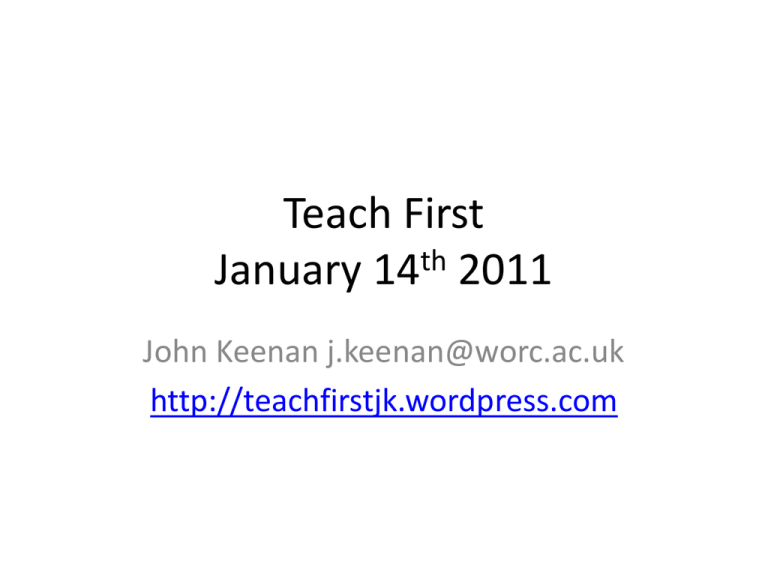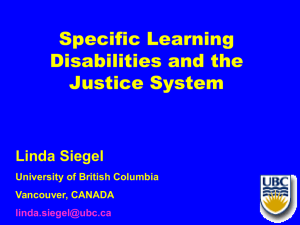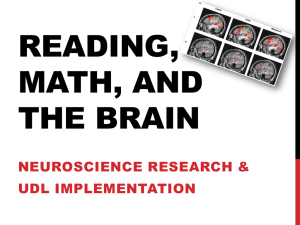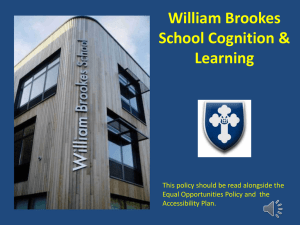teachfirstjan20113
advertisement

Teach First January 14th 2011 John Keenan j.keenan@worc.ac.uk http://teachfirstjk.wordpress.com Los Understand more about a specific education need. Be able to implement at least three strategies that would help someone with this SEN Dates Monday 28th February – RJA2 Q7 improving practice, professional development Monday 9th May – WA3 What theories influenced practice to improve the learning of two students with SEN Andrew to teacher: ‘you’re a stupid old woman who never went to school anyway’ Brenda sees a picture of a bee and butterfly: ‘there is a bee and a peanut butter’ We are all disabled Labelling Labelling What labelled disabilities are there? Labelling Spectrum ADHD Autism Dyslexia Sensory Dyspraxia Gervais Labelling •Self-fulfilling prophecy •Teacher expectancy effect – Rosenthal and Jacobson (1968) •Pupils with learning difficulties (Good and Brophy, 1984) Teacher smile at them less often; they call their names to answer a question less often; they demand less work from them Labelling ‘differently abled’ People are not disabled, society disables. we need labels for identity we need labels to redress the balance ‘the emphasis on ‘ability not disability’…is a denial of the status of the disabled person…’ Colin Barnes, Disabled People in Britain and Discrimination, 1991, London: Hurst and Co, p.203 ‘if disabled people are perceived as ‘normal’, then there is little need for the introduction of policies to facilitate their integration into ‘normal’ society’ Colin Barnes, Disabled People in Britain and Discrimination, 1991, London: Hurst and Co, p.203 Labelling 20% - learning difficulties physical, sensory, emotional, behavioural 1981 Education Act: ‘any difficulty of such a nature that the child requires something more than, or different from the majority of other children of the same age’ Cited in Doyle, 1996: 72 1. 2. 3. 4. Face Read through Pass opposing hand 6 times in succession Opposing hand write name ReserchAsisstent KloZing Dait: oh3-tooØØ11 SallarRee: BannEdd Fiyv, AytEen, 7Øniyn pownz - TweNteeWun,68Wun pownz pURr anNem (prOw raRtur fourpart tiym ars) Deppartmunt: WourSSter Bizness Skool - SenTEr foRe PeEpl @ Werk (SeaPeA@Dubbleyou) ARS: FlecKsabl beTweAnØ.6 FTE andfOoltIym (thertee7 ars purrweak) - buyneggociacean Start Dayt: AzsooNazpoSsable Dyouracean: Apoyntmant to0thurteefurst Jooliy2ØØ9inisherlee Ressponssabl tWo: Dirrekterof SeePee@Doubleyoue Ressponsabl fOUr: EnN/ay Inturvuedayt: NiynteanthMrcahTWOØØ11 Opposing hand up and say the third word of the question backwards • • • • What does it pay for 21+? How many hours per week? What’s the closing date for applications? When are they interviewing? ReserchAsisstent KloZing Dait: oh3-tooØØ11 SallarRee: BannEdd Fiyv, AytEen, 7Øniyn pownz - - TweNteeWun,68Wun pownz pURr anNem (prOw raRtur fourpart tiym ars) Deppartmunt: WourSSter Bizness Skool - SenTEr foRe PeEpl @ Werk (SeaPeA@Dubbleyou) ARS: FlecKsabl beTweAnØ.6 FTE andfOoltIym (thertee7 ars purrweak) buyneggociacean Start Dayt: AzsooNazpoSsable Dyouracean: Apoyntmant to0thurteefurst Jooliy2ØØ9inisherlee Ressponssabl tWo: Dirrekterof SeePee@Doubleyoue Ressponsabl fOUr: EnN/ay Inturvuedayt: NiynteanthsMrachTWOØØ11 From these experiences what does the dyslexic student need? Then he reddened furiously, felt his bowels sink with shame , scratched out what he had written, made an agonised effort...failed, became sullen with rage and humiliation, put the pen down and would have been torn to pieces rather than write another word’ D H Lawrence The Rainbow What do you already do for dyslexic pupils? Dys – painful, abnormal Lexicos – words of a language ‘It is illogical for a person to say, ‘My child cannot read because he is dyslexic’...It tells us no more than saying a person is bleeding badly because he has a haemorrhage or that someone has a high temperature because they are feverish.’ Doyle, 1996: 69 Pumfrey and Reason (1998) 11 definitions Rice and Brooks (2004) 40 definitions Cited in Mortimore, 2008: 50 What do you know about dyslexia? What % of pupils are dyslexic? How many in your class? ‘It seems to be a natural human phenomenon to want to classify events and concepts and then apply labels to them....the use of the label ‘dyslexia’ should present no problems just as long as it is understood that it may describe a variety of behaviours...it remains a challenge to educate the public regarding the concept of dyslexia’ Lawrence, 2009: 139-140 Identifying a condition has to have distinct: Aetiology (cause) Characteristics Prognosis (prediction) Response to interventions Pumfrey and Reason, 1991: 6 Alexia Auditory dyslexia Deep dyslexia vs Surface dyslexia (rules) Dyseidetic/Dysphonetic dyslexia Graphemic processor dyslexia Hyperlexia (speaking) L-type dyslexia vs P-type dyslexia Morphemic dyslexia Semantic processor dyslexia Strephosymbolia (mirror) Visual processor dyslexia Doyle, 1996: 70-71 Brain drawing Arrow the pattern for speech, reading and comprehension Doyle, 1996: 119 Causes of dyslexia Phonemes Grigorenko (1977) Chromosome s 6 and 15 linked to a weakness in phonological awareness fMRI phonological awareness (Shaywitz, 1996) Memory Retaining and attaching verbal labels (Snowling, 2001) Lateralization McLoughlin et al (2002) memory in the right and left frontal lobe, right more than left (Galaburda, 1989) but less dominance so ‘confused laterality’ Magnocellular Stein and Walsh (1997) speed of movement between cells History of dyslexia Kussmaul 1877 – word blindness Berlin 1877 – dyslexia Hinshelwood 1895 – congenital Norrie 1938 - organisation for dyslexic people Cf Miles and Miles 1990 Dyslexia: A Hundred Years On ‘The Education Act 1981...increase(d) markedly public awareness of the concept and the label’ Pumfrey and Reason, 1991: 5 Under Secretary – ‘baffling condition’ ‘Dyslexia is a specific learning difficulty of neurological and biological origin that is most often characterized by a significant discrepancy between measures of working memory and reasoning ability together with a weakness in the speed of processing information that may be manifested through weaknesses in a variety of educational attainments, particularly literary skills, as well as everyday tasks’ Lawrence, 2009: 38-39 ‘there is no international consensus over its definition’ Lawrence, 2009: 29 Causes: ‘the answer is not known’ Doyle, 1996: 112 left/right confusions visual memory visual discrimination essay structure visual processi ng Meares/ Irlen syndrome auditory discrimination may be fine overall picture good sequenci ng Dyslexia speech processi ng phonological awareness articulation may be fine time management spelling long term memory OK visual and auditory loops poor memory automati city OK for e.g. bicycle, swimming Not OK for coding and decoding How do I recognise a dyslexic pupil? *They ask the right questions, lively and interested, but any written work is relatively poor and/or poor handwriting. *They arrive late, hand in work late *They mix up instructions Typical issues 223 pupils Reading – 86% Spelling – bizarrre Left-right – 67% B and d – 65% Sentence memory Rhyme Miles (1983) cited in Doyle, 1996: 91-97 223 pupils Group task: consider how you could change one of your lessons to incorporate FOR ALL PUPILS the following three responses Teacher Response 1 Multiple Intelligence Gardner, dyslexic people have a different way of learning Intelligences: kill smn Support: pp29-30 Teacher Response 2 Mindmaps Support: pp11-14 Teacher Response 3: Spelling Rules Support: 52-60 Bottom up Top down ‘Most children learn to recognize printed words by attending first to higher order knowledge about language and life in general’ Pumfrey and Reason, 1991: 59 ‘the best practice of ‘articulatory encoding of visual stimuli’ (naming) may be provided by the activity of reading itself’ Pumfrey and Reason, 1991: 80 Previous experience of life Shared knowledge Purpose of language Language structures Reason 1990 Letter sounds words ‘Effort after meaning’ Bartlett 1932 cited in Pumfrey and Reason, 1991: 59-60 Fernald Multisensory Approach Orton-Gillingham Method Gillingham-Stillman Alphabetic Method Alpha to Omega Edith Norrie Letter Case The Bangor Teaching Programme Bannatyne’s Colour Phonics The Hickey Method Peabody Rebus Reading Programme Aston Index Aston Portfolio Assessment Spelling Made Easy (Brand, 1984) The Icon Approach Reading Recovery (1988) The English Colour Code Programmed Reading Course (1976) Patterns of Sound (1968) Pictogram System (1973) Signposts to Spelling (1978) ARROW (Aural – Read – Respond – Oral – Written) (1990) Attack – a-Track Simultaneous Oral Spelling Psycho-motor programmes Embedded pictures Mnemonic drawings Finger spelling Syllabification Cursive script Develop the wiki for all to see and use for WA3 http://teachfirstdyslexia.wetpaint.com Support strategies • • • • • • • • • • • • • Write down main points Use pictures, flow-charts, mind-maps Colour all crucial information on the walls Practical/kinaesthetic work Interact one-to-one Signpost topics and key points Allow students time to absorb information. Use recorders Always give out homework instructions ready printed VAK ‘primacy and recency’ rule Use a font without serifs; Arial or Comic Sans. Print some copies on blue and cream paper. Your score out of 13? Teacher solutions http://www.dys-add.com/DV3Handout.pdf Specially prepared work sheets Teaching any specialised vocabulary prior to the lesson Recording of literature Photocopied notes Bibliography Bennett, D. 2006 Dyslexia Pocketbook Teachers’ pocketbooks Buzan,T. 1997 The Mind Map Book London : BBC Saunders & White 2002 How Dyslexics Learn Evesham: patoss Eckersley, J. 2004 Coping with Dyspraxia Sheldon Press Biggs, V. 2005 Caged in Chaos Jessica Kingsley Pubs. Mortimore T 2008 Dyslexia and Learning Styles Chichester: John Wiley and Sons Hunter-Carsch M and Herrington M 2001 Dyslexia and Effective Learning London: Whurr Pumfrey P and Reason R 1991 Specific Learning Difficulties London: Routledge Doyle J 1996 Dyslexia: an Introductory Guide London: Whurr Publishers Massey J 2008 Meeting the Needs of Students with Dyslexia London: Network Continuum Edwards J 1994 The Scars of Dyslexia London: Cassell Stirling EG 1987 Help for the Dyslexic Adolescent Chippenham: St David’s College Turner E and Pughe J 2003 Dyslexia and English London: David Fulton Publishers British Dyslexia Association www.bda-dyslexia.org.uk Dyslexia Institute www.dyslexia-inst.org.uk








